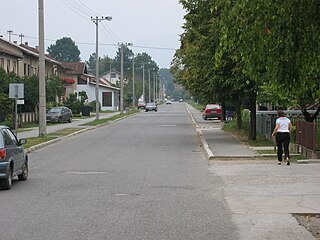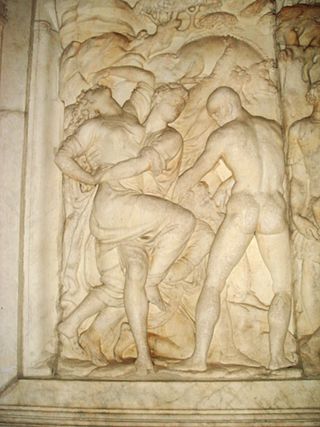Related Research Articles

The Yugoslav Wars were a series of separate but related ethnic conflicts, wars of independence, and insurgencies that took place in the SFR Yugoslavia from 1991 to 2001. The conflicts both led up to and resulted from the breakup of Yugoslavia, which began in mid-1991, into six independent countries matching the six entities known as republics that had previously constituted Yugoslavia: Slovenia, Croatia, Bosnia and Herzegovina, Montenegro, Serbia, and Macedonia. SFR Yugoslavia's constituent republics declared independence due to unresolved tensions between ethnic minorities in the new countries, which fuelled the wars. While most of the conflicts ended through peace accords that involved full international recognition of new states, they resulted in a massive number of deaths as well as severe economic damage to the region.

Edward Sebastian Vulliamy is a British-born, Irish-Welsh journalist and writer.

Omarska is a small town near Prijedor in northwestern Bosnia and Herzegovina. The town includes an old iron mine and ore processing plant. During the Bosnian War it was the site of the Omarska concentration camp.

Vilina Vlas was a rape camp active during the Bosnian War. It served as one of the main detention facilities where Bosniak civilian prisoners were beaten, tortured and murdered and women were raped by prison guards during the Višegrad massacres in the Bosnian War of the 1990s. It is located about four kilometers north-east of Višegrad, in the village of Višegradska Banja.

The Republika Srpska was a self-proclaimed statelet in Southeastern Europe under the control of the Army of Republika Srpska during the Bosnian War. It claimed to be a sovereign state, though this claim was only partially recognized by the Bosnian government in the Geneva agreement, the United Nations, and Yugoslavia. For the first six months of its existence, it was known as the Serbian Republic of Bosnia and Herzegovina.
The Omarska camp was a concentration camp run by the Army of Republika Srpska in the mining town of Omarska, near Prijedor in northern Bosnia and Herzegovina, set up for Bosniak and Bosnian Croat prisoners during the Prijedor ethnic cleansing. Functioning in the first months of the Bosnian War in 1992, it was one of 677 alleged detention centers and camps set up throughout Bosnia and Herzegovina during the war. While nominally an "investigation center" or "assembly point" for members of the Bosniak and Croatian population, Human Rights Watch classified Omarska as a concentration camp.

Manjača was a concentration camp which was located on mount Manjača near the city of Banja Luka in northern Bosnia and Herzegovina during the Bosnian War and the Croatian War of Independence from 1991 to 1995. The camp was founded by the Yugoslav People's Army (JNA) and authorities of the Republika Srpska (RS) and was used to collect and confine thousands of male prisoners of Bosniak and Croat nationalities.

The Trnopolje camp was an internment camp established by Republika Srpska military and police authorities in the village of Trnopolje near Prijedor in northern Bosnia and Herzegovina, during the first months of the Bosnian War. Also variously termed a concentration camp, detainment camp, detention camp, prison, and ghetto, Trnopolje held between 4,000 and 7,000 Bosniak and Bosnian Croat inmates at any one time and served as a staging area for mass deportations, mainly of women, children, and elderly men. Between May and November 1992, an estimated 30,000 inmates passed through. Mistreatment was widespread and there were numerous instances of torture, rape, and killing; ninety inmates died.
The Keraterm camp was a concentration camp established by Republika Srpska military and police authorities near the town of Prijedor in northern Bosnia and Herzegovina during the Bosnian War. The camp was used to collect and confine between 1,000 and 1,500 Bosniak and Bosnian Croat civilians.

There was a campaign of ethnic cleansing in the area of the town of Foča committed by Serb military, police, and paramilitary forces on Bosniak civilians from 7 April 1992 to January 1994 during the Bosnian War. By one estimate, around 21,000 non-Serbs left Foča after July 1992.

Rape during the Bosnian War was a policy of mass systemic violence targeted against women. While men from all ethnic groups committed rape, the vast majority of rapes were perpetrated by Bosnian Serb forces of the Army of the Republika Srpska (VRS) and Serb paramilitary units, who used rape as an instrument of terror and key tactics as part of their programme of ethnic cleansing. Estimates of the number of women raped during the war range between 10,000 and 50,000. Accurate numbers are difficult to establish and it is believed that the number of unreported cases is much higher than reported ones.

During the Bosnian War, there was an ethnic cleansing campaign committed by the Bosnian Serb political and military leadership – Army of the Republika Srpska, mostly against Bosniak and Croat civilians in the Prijedor region of Bosnia and Herzegovina in 1992 and 1993. The composition of non-Serbs was drastically reduced: out of a population of 50,000 Bosniaks and 6,000 Croats, only some 6,000 Bosniaks and 3,000 Croats remained in the municipality by the end of the war. After the Srebrenica massacre, Prijedor is the area with the second highest rate of civilian killings committed during the Bosnian War. According to the Sarajevo-based Research and Documentation Center (IDC), 4,868 people were killed or went missing in the Prijedor municipality during the war. Among them were 3,515 Bosniak civilians, 186 Croat civilians and 78 Serb civilians. As of October 2013, 96 mass graves have been located and around 2,100 victims have been identified, largely by DNA analysis.

Wartime sexual violence is rape or other forms of sexual violence committed by combatants during an armed conflict, war, or military occupation often as spoils of war, but sometimes, particularly in ethnic conflict, the phenomenon has broader sociological motives. Wartime sexual violence may also include gang rape and rape with objects. It is distinguished from sexual harassment, sexual assaults and rape committed amongst troops in military service.
Bakira Hasečić is a Bosnian human rights activist who advocates for the rights of women who were raped during the Bosnian War.

The Doboj ethnic cleansing refers to war crimes, including murder, deportation, persecution and wanton destruction, committed against Bosniaks and Croats in the Doboj area by the Yugoslav People's Army and Serb paramilitary units from May until September 1992 during the Bosnian war. On 26 September 1997, Serb soldier Nikola Jorgić was found guilty by the Düsseldorf Oberlandesgericht on 11 counts of genocide involving the murder of 30 persons in the Doboj region, making it the first Bosnian Genocide prosecution. The International Criminal Tribunal for the former Yugoslavia (ICTY) classified it as a crime against humanity and sentenced seven Serb officials.

Ethnic cleansing occurred during the Bosnian War (1992–95) as large numbers of Bosnian Muslims (Bosniaks) and Bosnian Croats were forced to flee their homes or were expelled by the Army of Republika Srpska and Serb paramilitaries. Bosniaks and Bosnian Serbs had also been forced to flee or were expelled by Bosnian Croat forces, though on a restricted scale and in lesser numbers. The UN Security Council Final Report (1994) states while Bosniaks also engaged in "grave breaches of the Geneva Conventions and other violations of international humanitarian law", they "have not engaged in "systematic ethnic cleansing"". According to the report, "there is no factual basis for arguing that there is a 'moral equivalence' between the warring factions".
Fikret Alić is a Bosniak survivor of the 1992 Keraterm and Trnopolje concentration camps near the city of Prijedor in northwest Bosnia and Herzegovina. The journalist Ed Vulliamy, whose reporting of Trnopolje and another concentration camp at Omarska helped draw public attention to the atrocities being perpetrated in the Prijedor camp system, described Alić as being "probably the most familiar figure in the world" in the summer of 1992, when the image of his emaciated frame, seen behind barbed wire at the Trnopolje concentration camp, was seen around the world as emblematic of the violence being inflicted on non-Serb civilians by Bosnian Serbs under the leadership of Radovan Karadžić during the Bosnian War and genocide.
Nusreta Sivac is a Bosnian activist for victims of rape and other war crimes and a former judge. During the Bosnian War she was an inmate at the Bosnian Serb-run Omarska camp in Prijedor, Bosnia and Herzegovina where she and other women at the camp were raped, beaten, and tortured. After the camp's closure in August 1992 due to press coverage, she became an activist for victims of rape and is credited with helping in the recognition of wartime rape as a war crime under international law. She is a member of the Women's Association of Bosnia and Herzegovina.
Thomas Halaczinsky is a filmmaker, producer, photographer, and writer. He is the youngest child of composer and painter Rudolf Halaczinsky.

Bosnian genocide denial is the act of denying the occurrence of the systematic Bosnian genocide against the Bosniak Muslim population of Bosnia and Herzegovina, or asserting it did not occur in the manner or to the extent that has been established by the International Criminal Tribunal for the former Yugoslavia (ICTY) and the International Court of Justice (ICJ) through proceedings and judgments, and described by comprehensive scholarship.
References
- Goodman, Walter (3 March 1997). "Women as Victims of the Bosnian War". New York Times.
- Purohit, Rajeev (1997). "Film Chronicles Suffering at Omarska Concentration Camp". Human Rights Brief. 4 (2): 4–5.
- Ratner, Hannah (20 November 2011). ""Calling the Ghosts" and the Continued Fight to End Violence Against Women". United Nations Entity for Gender Equality and the Empowerment of Women. Archived from the original on 2012-10-17. Retrieved 2013-04-08.